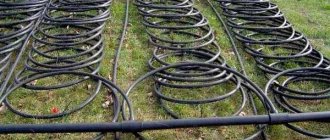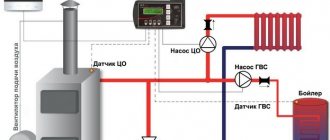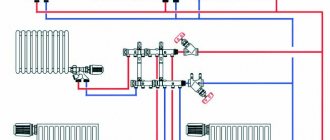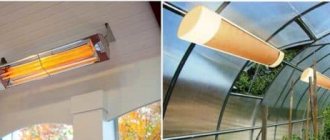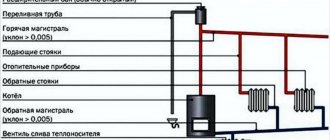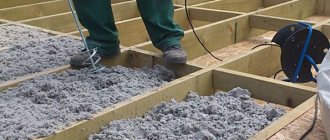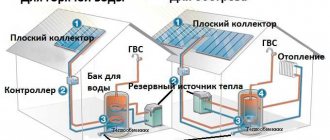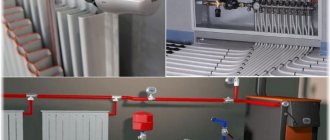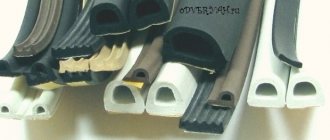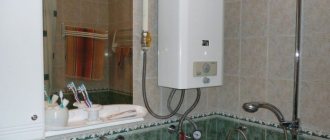Air heat pumps belong to the category of modern equipment that uses alternative energy sources. The source of heat for them is the atmosphere around us. consuming 1 kW of electricity using these installations you can obtain 4 kW of thermal energy. At the same time, they are absolutely environmentally safe and do not require burning fuel.
Important ! If you want to use this system as an alternative to gas heating, please note that the heating value of 1 kW of electricity is equal to the heat generated by 0.11 m3 of natural gas. More details about the amount of energy released by various materials can be found in this table.
Types of heat pumps
There are two types of installations. In one, the thermal energy of atmospheric air is transferred to heat the coolant liquid in the heating system and hot water for household needs. In another case, the air inside the room is heated directly, without the possibility of heating hot water; this is called the air-to-air principle.
In addition to atmospheric ones, there are geothermal and hydrothermal heat pumps. In their work, heat is taken from a drilled well or reservoir. However, additional costs associated with drilling, corrosion protection, electrical safety and siltation significantly complicate installation and increase the amount of capital costs.
Air-to-water heat pump systems are the best option in terms of reliability, comfort level and cost. At the same time, they have a long service life.
Tips for purchasing and installing a heat pump heating system
Based on the disadvantages of a heat pump, it is ideal for regions with moderate winters and is ineffective in cool and northern climate zones. But do not be upset if in winter in your area there are cold temperatures below -7C. In this situation, there are the following solutions:
- Inclusion of a buffer tank in the heating system, which will accumulate the resulting heat. One tank (small, apartment size) with the source turned off can evenly distribute heat throughout the system for up to a day. This is a convenient option for areas where severe frosts usually do not last long.
- Installation of an auxiliary heat source: gas or electric boiler. When a cheap heat pump cannot work, a less economical “backup” will replace it.
- Combination of the two previous techniques.
Attention! As with any heating system, before installation it is important to carefully check the heat loss of your home and, if possible, insulate it. The warmer the house, the less power you will need the device.
Operating principle of an air-water pump
As already mentioned, the main source of thermal energy for installations of this type is atmospheric air. The fundamental basis for the operation of air pumps is the physical property of liquids to absorb and release heat during a phase transition from a liquid to a gaseous state, and vice versa . As a result of the change in state, temperature is released. The system works like a refrigerator in reverse.
To effectively use these properties of the liquid, a low-boiling refrigerant (freon, freon) circulates in a closed circuit, the design of which includes:
- electric compressor;
- fan-driven evaporator;
- throttle (expansion) valve;
- plate heat exchanger;
- copper or metal-plastic circulation tubes connecting the main elements of the circuit.
The movement of the refrigerant along the circuit is carried out due to the pressure developed by the compressor. To reduce heat losses, pipes are covered with a heat-insulating layer of artificial rubber or foamed polyethylene with a protective metallized coating. Freon or freon is used as a refrigerant, which can boil at subzero temperatures and does not freeze down to -40°C.
The entire work process consists of the following sequential cycles:
- The evaporator core contains liquid refrigerant whose temperature is lower than that of the outside air. During active blowing of the radiator, thermal energy from low-potential air is transferred to the freon, which boils and turns into a gaseous state. At the same time, its temperature rises.
- The heated gas enters the compressor, where it heats up even more during the compression process.
- In a compressed and heated state, the refrigerant vapor is supplied to a plate heat exchanger, where the heating system coolant circulates through the second circuit. Since the coolant temperature is significantly lower than that of the heated gas, freon actively condenses on the heat exchanger plates, releasing heat into the heating system.
- The cooled vapor-liquid mixture enters the throttle valve, which allows only cooled, low-pressure liquid refrigerant to pass to the evaporator. After which the whole cycle repeats.
To increase the heat transfer efficiency of the tube, spiral fins are wound onto the evaporator. Calculation of the heating system, selection of circulation pumps and other equipment must take into account the hydraulic resistance and heat transfer coefficient of the installation's plate heat exchanger.
Video overview of the system design and its operation
Inverter heat pumps
The presence of an inverter as part of the installation allows for a smooth start-up of the equipment and automatic control of modes depending on the outside temperature. This allows you to maximize the efficiency of the heat pump by:
- achieving efficiency at the level of 95-98%;
- reducing energy consumption by 20-25%;
- minimizing loads on the electrical network;
- increasing the service life of the installation.
As a result, the indoor temperature is stably maintained at the same level, regardless of weather changes. At the same time, the presence of an inverter complete with an automated control unit will provide not only winter heating, but also the supply of cooled air in summer when the weather is hot.
At the same time, it should be taken into account that the presence of additional equipment always entails an increase in its cost and an increase in the payback period.
Calculation of a horizontal heat pump collector
The efficiency of a horizontal collector depends on the temperature of the medium in which it is immersed, its thermal conductivity, and the area of contact with the surface of the pipe. The calculation method is quite complex, so in most cases averaged data is used.
- 10 W – when buried in dry sandy or rocky soil;
- 20 W – in dry clay soil;
- 25 W – in wet clay soil;
- 35 W – in very damp clay soil.
Thus, to calculate the length of the collector (L), the required thermal power (Q) should be divided by the calorific value of the soil (p):
L = Q/p.
The values given can only be considered valid if the following conditions are met:
- The area of land above the sewer is not developed, shaded or planted with trees or bushes.
- The distance between adjacent turns of the spiral or sections of the “snake” is at least 0.7 m.
When calculating the collector, it should be taken into account that the soil temperature after the first year of operation drops by several degrees.
Operation of the heating system from such a pump
The operating principle of the installation itself was described above. As a result, the coolant is heated in the second circuit of the heat exchanger, which will subsequently serve as a heat source for heating the building or individual rooms.
The classic option for distributing heated coolant is to connect the heat exchanger with two separate lines to the distribution comb and the water heating boiler. Heating devices, heated floors and other equipment are, in turn, connected to the comb. This distribution is necessary due to the different operating modes of hot water supply and heating systems.
The line of air-to-water heat pumps determines the power of installations from 2 to 120 kW, which allows you to select equipment for heating and hot water supply to a residential building of any size.
Cold air mode
The design of heat pumps allows not only to heat the house in winter , but also to provide cooled air on hot days in summer . To do this, the refrigerant circulation is started in a reverse cycle. However, cooling the heating devices will not provide the necessary effect since the cold air falling down will not be able to create comfortable conditions throughout the entire volume of the room. Therefore, in order to use an air-to-water installation for air conditioning, a fan-driven convector will be required.
In addition, a 4-way valve, a second butterfly valve and 2 pipe lines are additionally installed in the circulation circuit. When the valve is switched, the line closes in the direction of the “winter” throttle and opens in the direction of the “summer” throttle, and the cooled coolant is supplied to the convector. Hot water heating will also be turned off.
The cost of such an improvement, taking into account additional equipment, materials and labor, can be quite comparable to the cost of an air conditioner. Therefore, in most cases it will be quite reasonable to abandon operation in split mode and simply buy an air conditioning unit.
Details
Advantages and disadvantages of air-water pumps
Like any equipment, pumps have pros and cons. The advantages include:
1.The equipment is easy to install. The primary circuit, closed on the evaporator, does not require reservoirs or excavation work.
2.air, as an energy carrier, is everywhere, unlike land and reservoirs. Air pumps can be used in apartments; they do not require permission from special authorities.
3. The air-water pump can be connected to the ventilation network, the power of the unit will be used to increase air exchange in the rooms.
4.pumps operate with minimal noise and can be programmed.
The disadvantages include:
1.The unit is effective at a certain ambient temperature. The efficiency of the unit is higher in summer than in winter.
2.pumps can operate in slight frosts.
Attention! The pumps do not operate at 7 degrees below zero; this does not apply to industrial pumps of this type. They can be turned on at minus twenty-five degrees.
3. The air-type unit does not belong to autonomous power plants. To operate, it requires electricity; it transforms 1 kilowatt per hour from 11 to 14 mJ.
How to build an air-water pump yourself
Air-to-water pumps have a simple design; you can make them yourself. To make the device, you will need inexpensive tools and parts:
1. compressor of an old split system, which can be bought at repair shops.
2.tank, 100 liters in volume, made of steel; a tank from an old washing machine is suitable.
3. containers made of polymer material with a wide neck, you can take a can.
4.copper pipes with an internal cross-section greater than one millimeter. You will need to buy them.
5. shutter - control valves in the form of a drain valve, a valve to bleed air, a safety valve.
6.elements for fastening in the form of brackets, clamps, clips.
You will also need to purchase freon as a refrigerant, the simplest control unit. Without the latter, it is impossible to use heat pumps, because it is necessary to make the operation of the compressor synchronous with respect to the temperature conditions on the condenser and evaporator housings.
How to assemble the device
When assembling the structure, you should follow certain steps. According to the instructions, you need to do:
1.copper pipe is needed to make the coil. Its dimensions must be suitable for the cross-section and height of the steel tank.
2. you need to insert the coil into the container, leave the ends of the pipe outside the tank, seal the tank, make an inlet fitting at the bottom, and an outlet fitting at the top. The result will be a finished capacitor with outlets for the direct pipe of the heating system - the fitting on the top, and the return circuit - the fitting on the bottom.
3. The compressor should be attached to the wall using brackets. Next, you need to connect the compressor pressure fitting to a copper pipe on top of the tank.
4.make another coil from a copper pipe. Its dimensions must be suitable for the polymer can in cross-section and height.
5. Insert the coil inside the can; a fan is installed at one end of it, with the help of which air is pumped into the snake-shaped pipe. You need to make a couple of outlets from the can body. This device will act as the evaporator of the system. It is attached to the facade of the building, or inside the ventilation.
6. At the condenser, connect the outlet from below with the outlet on the evaporator, also from below. A throttle should be inserted into the finished pipeline for control.
7. The outlet from the top of the can should be connected to the compressor pipe intended for suction.
8. Refrigerant is poured into the compressor, then the control unit is connected to the valve on the throttle.
How to calculate pump power
The pump power parameter is influenced by many factors. These include:
1.refrigerant volume.
2.surface area of serpentine pipes inside the evaporator, condenser.
3. the expected volume of heat transfer to the heating system.
Attention! It is most convenient to calculate power using special programs that take into account all the nuances of the system.
Power can be calculated using an online calculator. You need to enter certain parameters into the calculator:
1.area of the room, ceiling height to calculate the volume.
2. the region where the house is located to determine the average annual air temperature, which affects the level of evaporator performance.
3.the degree of insulation of the walls and roof of the room in order to calculate the expected calorie content of heating.
At the end of the program, coefficients are obtained based on the last parameters; the volume of the building must be multiplied by these numbers. The resulting value is compared with the numbers from the table; they indicate the required pump power for a given situation.
Attention! For example, to heat an area of one hundred square meters, a pump of 5 kilowatts is required, and a pump of 28 kilowatts is needed to heat an area of three hundred and fifty square meters.
Advantages and disadvantages
| Advantages | Flaws |
| economically advantageous type of heating equipment with the lowest possible capital investment and operating costs | complex connection diagram for operation in air cooling mode |
| possibility of simultaneous heating of premises and preparation of hot water for household needs | disproportionate increase in energy consumption when the outside temperature drops |
| availability of high-temperature models capable of ensuring stable operation of heated floors, fan coils and convectors | probable heating stop at outside temperatures below -25°C |
| high energy efficiency of equipment at level A+++ | presence of background noise during operation |
| Possibility of working together with heating boilers | dependence on a stable power supply. |
| automated equipment control | |
| easy installation and maintenance | |
| the ability to work on a heat accumulator allows you to use electricity more economically, taking into account tariffs by time of day |
Most models work fine down to an outside temperature of -15°C. With further cooling, the efficiency of the system decreases sharply. This is due to such a technical characteristic as the boiling point of the refrigerant. For the most common brands it ranges from -20°C to -35°C. At lower air temperatures, the refrigerant stops boiling in the evaporator and the system stops operating. Therefore, for residential buildings and cottages in a cold climate zone, an additional boiler or fireplace is required.
Installation of equipment
The evaporator unit can be installed on supports near the ground or on the wall of a building. To protect against the noise of a running compressor, it is recommended to install the second unit in a separate room, in the basement or attic. In this case, it is necessary to take the manufacturer’s recommended distance between blocks of no more than 10 meters.
After this, the blocks are connected to each other by metal-plastic or copper tubes in reinforced thermal insulation with foil protection. At the last stage of installation, the heating system pipes are connected to the second circuit of the plate heat exchanger and the power supply line is connected.
Installation nuances
When choosing a water-to-water heat pump, it is important to calculate its operating conditions. If the line is immersed in a body of water, its volume must be taken into account (for an enclosed lake, pond, etc.), and when installed in a river, the flow speed
If miscalculations are made incorrectly, the pipes will freeze with ice and the efficiency of the heat pump will be zero.
What is a chiller and how does it work?
When sampling groundwater, seasonal fluctuations must be taken into account. As you know, in spring and autumn the amount of groundwater is higher than in winter and summer. Namely, the main operating time of the heat pump will be in winter. To pump and pump water, you need to use a conventional pump, which also consumes electricity. Its costs should be included in the total and only after calculating the efficiency and payback period of the heat pump.
A great option is to use artesian water. It emerges from deep layers by gravity, under pressure. But you will have to install additional equipment to compensate for it. Otherwise, the heat pump components may be damaged.
The only disadvantage of using an artesian well is the cost of drilling. The costs will not soon be recouped due to the lack of a pump to lift water from a regular well and pump it into the ground.
How does this system work?
The world around us is full of energy, we just need to collect it and use it correctly. This is what air/water heat pumps are designed for. With their help, you can collect low-potential energy from the environment and convert it into high-potential heat, which can heat your home very effectively. Experts call this process the reverse Carnot principle, on the basis of which refrigeration units operate.
Using a powerful fan, regular air is drawn in from outside. It is in contact with the evaporator, inside of which there is a refrigerant circulating through the coil. When heated, the refrigerant evaporates and enters the compressor. Here it is compressed and heated to a temperature of about 75 degrees and enters the condenser under pressure. There, the refrigerant condenses and turns into a liquid state, releasing heat to the home heating system. The liquid refrigerant enters the evaporator, where it is heated by the action of outside air, etc. The cycle of “heating-evaporation-compression-condensation” is repeated over and over again.
The external unit of the air-to-water heat pump is placed on the site, choosing a place with good air circulation close to the house
Heat pumps of all types are recommended to be used in conjunction not with traditional radiators, but with those types of heating that do not require heating the coolant to high temperatures. These include “warm floors”, air heating, large area radiators, etc.
Drilling wells for a heat pump system
It is better to entrust the construction of a well to a professional installation organization. It is optimal for representatives of the company selling the heat pump to do this. Thus, it is possible to take into account all the nuances of drilling and the location of probes from the structure, and fulfill other requirements.
A specialized organization will assist in obtaining permission to drill a well for probes for a ground source heat pump. According to the law, the use of groundwater for economic purposes is prohibited. We are talking about using water located below the first aquifer for any purpose.
As a rule, the procedure for drilling vertical systems must be agreed upon with government authorities. Lack of permits leads to penalties.
After receiving all the necessary documents, installation work begins according to the following procedure:
- Drilling points and probe locations on the site are determined, taking into account the distance from the building, landscape features, the presence of groundwater, etc. Maintain a minimum gap between the wells and the house of at least 3 m.
- Equipment for drilling, as well as equipment necessary for performing landscaping work, is imported. A drill and a breaker are required for vertical and horizontal installation. To drill the soil at an angle, drilling rigs with a fan circuit are used. The most widely used model is the one that operates on crawler tracks. Probes are placed in the resulting wells and the gaps are filled with special solutions.
Drilling wells for heat pumps (with the exception of cluster wiring) is allowed at a distance from the building of at least 3 m. The maximum distance to the house should not exceed 100 m. The project is carried out based on these standards.
What depth should the well be
The depth is calculated based on several factors:
- Dependence of efficiency on well depth - there is such a thing as an annual decrease in heat transfer. If the well is very deep, and in some cases it is necessary to make a channel up to 150 m, the heat received will decrease every year, and over time the process will stabilize. Making a well of maximum depth is not the best solution. Usually several vertical channels are made, spaced apart from each other. The distance between wells is 1-1.5 m.
- Calculation of the depth of drilling a well for probes is carried out taking into account the following: the total area of the local area, the presence of groundwater and artesian wells, the total heated area. So, for example, the depth of drilling wells with high groundwater is sharply reduced compared to making wells in sandy soil.
Creating geothermal wells is a complex technical process. All work, from design documentation to commissioning of the heat pump, must be carried out exclusively by specialists.
To calculate the approximate cost of work, use online calculators. The programs help to calculate the volume of water in the well (affects the amount of propylene glycol required), its depth and perform other calculations.
How to fill a well
The choice of materials often falls entirely on the owners themselves.
The contractor may advise you to pay attention to the type of pipe and recommend a composition for filling the well, but the final decision will have to be made independently. What are the options?
- Pipes used for wells use plastic and metal contours. As practice has shown, the second option is more acceptable. The service life of a metal pipe is at least 50-70 years; the metal walls have good thermal conductivity, which increases the efficiency of the collector. Plastic is easier to install, so construction organizations often offer it.
- Material for filling gaps between pipe and soil. Well plugging is a mandatory rule. If the space between the pipe and the soil is not filled, shrinkage will occur over time, which can damage the integrity of the circuit. The gaps are filled with any building material with good thermal conductivity and elasticity, such as Betonite. Filling the well for the heat pump should not interfere with the normal circulation of heat from the ground to the collector. The work is done slowly so as not to leave any voids.
Even if drilling and positioning of probes from the structure and from each other are done correctly, after a year additional work will be required due to shrinkage of the collector.
